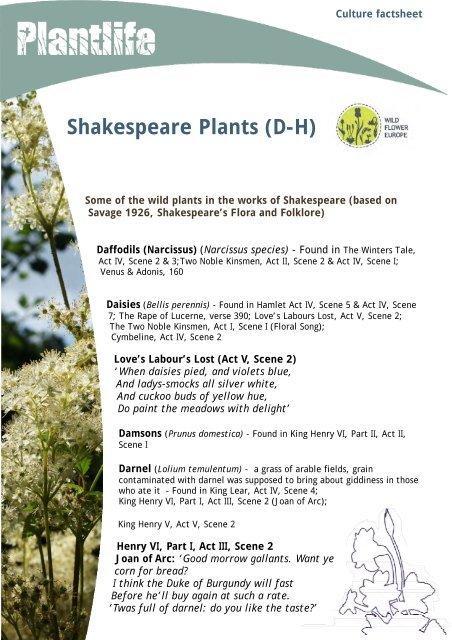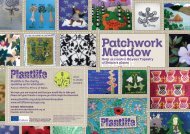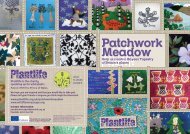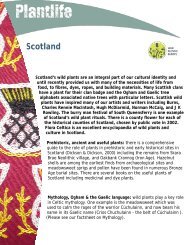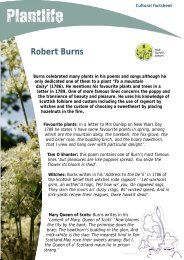Shakespeare Plants (D-H).pub - Wildflower Europe
Shakespeare Plants (D-H).pub - Wildflower Europe
Shakespeare Plants (D-H).pub - Wildflower Europe
You also want an ePaper? Increase the reach of your titles
YUMPU automatically turns print PDFs into web optimized ePapers that Google loves.
Culture factsheet<br />
<strong>Shakespeare</strong> <strong>Plants</strong> (D-H)<br />
Some of the wild plants in the works of <strong>Shakespeare</strong> (based on<br />
Savage 1926, <strong>Shakespeare</strong>’s Flora and Folklore)<br />
Daffodils (Narcissus) (Narcissus species) - Found in The Winters Tale,<br />
Act IV, Scene 2 & 3;Two Noble Kinsmen, Act II, Scene 2 & Act IV, Scene I;<br />
Venus & Adonis, 160<br />
Daisies (Bellis perennis) - Found in Hamlet Act IV, Scene 5 & Act IV, Scene<br />
7; The Rape of Lucerne, verse 390; Love’s Labours Lost, Act V, Scene 2;<br />
The Two Noble Kinsmen, Act I, Scene I (Floral Song);<br />
Cymbeline, Act IV, Scene 2<br />
Love’s Labour’s Lost (Act V, Scene 2)<br />
‘When daisies pied, and violets blue,<br />
And ladys-smocks all silver white,<br />
And cuckoo buds of yellow hue,<br />
Do paint the meadows with delight’<br />
Damsons (Prunus domestica) - Found in King Henry VI, Part II, Act II,<br />
Scene I<br />
Darnel (Lolium temulentum) - a grass of arable fields, grain<br />
contaminated with darnel was supposed to bring about giddiness in those<br />
who ate it - Found in King Lear, Act IV, Scene 4;<br />
King Henry VI, Part I, Act III, Scene 2 (Joan of Arc);<br />
King Henry V, Act V, Scene 2<br />
Henry VI, Part I, Act III, Scene 2<br />
Joan of Arc: ‘Good morrow gallants. Want ye<br />
corn for bread?<br />
I think the Duke of Burgundy will fast<br />
Before he’ll buy again at such a rate.<br />
‘Twas full of darnel: do you like the taste?’
Burgundy: ‘Scoff on, vile fiend, and shameless courtesan!<br />
I trust, ere long, to choke thee with thine own,<br />
And make thee curse the harvest of that corn.’<br />
Dewberries (Rubus caesius) - Found in A Midsummer-Nights Dream, Act III, Scene I<br />
Docks (Rumex species) - King Henry V, Act V, Scene 2<br />
Dogberry (Dog Wood) (Cornus sanguinea) - Found in Much Ado About Nothing,<br />
Act III, Scene 3<br />
Eglantine (Sweet Briar) (Rosa rubiginosa) - Found in A Midsummer-<br />
Nights Dream, Act II, Scene 2; Cymbeline, Act IV, Scene 2<br />
Elder (Sambucus nigra) - Found in Titus Andronicus, Act II, Scene 4;<br />
Loves Labours Lost, Act V, Scene 2; Cymbeline, Act IV, Scene 2;<br />
The Merry Wives of Windsor, Act II, Scene 3; King Henry V, Act IV, Scene I<br />
(children’s use of elder as a spring or pop gun)<br />
Elm (Ulmus species) - Found in A Midsummer Nights Dream, Act IV, Scene 1<br />
Eringoes (Sea Holly) (Eryngium maritimum) - the candied roots of the<br />
sea holly were a great delicacy in Tudor England and Colchester was a<br />
centre of eringo production. Found in The Merry Wives of Windsor, Act V,<br />
Scene 5<br />
The Merry Wives of Windsor, Act V, Scene 5 (Falstaff)<br />
‘My doe with the black scut! Let the sky rain potatoes;<br />
let it thunder to the tune of ‘Green Sleeves’;<br />
hail kissing-comfits and snow eringoes;<br />
let there come a tempest of provocation,<br />
I will shelter me here.’<br />
Fennel (Foeniculum vulgare) - Found in King Henry IV, Part 2, Act<br />
II, Scene 4; Hamlet, Act IV, Scene 5<br />
Ferns - Found in King Henry IV, Part I, Act II, Scene I<br />
Fig (Ficus carica) - Found in Othello Act I, Scene 3;<br />
A Midsummer-Night’s Dream Act III, Scene I;<br />
King Henry IV, Part 2, Act V, Scene 3;<br />
Anthony & Cleopatra Act I, Scene 2;<br />
King Henry VI, Part II, Act II, Scene 3
Flag (could be Acorus calamus or any tall water plant, reed, rush, sedge or<br />
bulrush) - Found in Anthony & Cleopatra, Act I, Scene 4<br />
Flax (Linum usitatissum) - Found in The Two Noble Kinsmen Act V, Scene 3;<br />
King Lear, Act III, Scene 7; King Henry VI, Part II, Act V, Scene 2;<br />
Merry Wives of Windsor, Act V, Scene 5; Twelfth Night, Act I, Scene 3;<br />
The Winter’s Tale, Act I, Scene 3; Hamlet Act IV, Scene 5<br />
Fumiter (Fumitory) (Fumaria species) - Found in King Henry V, Act V, Scene 2<br />
King Lear, Act IV, Scene 4<br />
King Lear, Act IV, Scene IV (Cordelia)<br />
‘Alack, ‘tis he:<br />
Why, he was met<br />
Even now<br />
As mad as the vex’d sea;<br />
Singing aloud;<br />
Crown’d with rank fumiter, and furrow-weeds,<br />
With hoar-docks, hemlock, nettles, cuckoo-flowers,<br />
Darnel, and all the idle weeds that grow<br />
In our sustaining corn.’<br />
Furze, Gorse, Goss (Ulex europaeus) - Found in The Tempest, Act IV,<br />
Scene I<br />
Gooseberry (RIbes uva-#) - King Henry IV, Part II, Act I, Scene 2<br />
Grasses — separate mentions of grass & hay<br />
Harebell—Savage believes that the ‘azur’d harebell’ in Cymbelline is<br />
the bluebell (Hyancinthoides non-scripta)<br />
Cymbeline Act IV, Scene 2<br />
‘Whilst summer lasts, and I live here Fidele,<br />
I’ll sweeten thy sad grave, thou shalt not lack<br />
The flower that’s like thy face, pale primrose, not<br />
The azur’d hare-bell, like thy veins’<br />
Hawthorn (Crataegus monogyna) - Found in King<br />
Henry VI, Part III, Act II, Scene 5; As You Like It, Act<br />
III, Scene 2<br />
Hazelnuts & Filberts (Corylus avellana) - Found<br />
in The Taming of the Shrew, Act II, Scene 2; The<br />
Tempest, Act II, Scene 2
Heath (Calluna vulgaris) - Found in The Tempest, Act I, Scene I<br />
Hemlock (Conium maculatum) - Found in Macbeth, Act IV, Scene I;<br />
King Lear, Act IV, Scene 4; King Henry V, Act V, Scene 2<br />
Macbeth, Act IV, Scene I (Third Witch)<br />
‘Scale of dragon, tooth of wolf;<br />
Witches’ mummy; maw, and gulf,<br />
Of the ravin’d salt-sea shark;<br />
Root of hemlock, digg’d i’ the dark;<br />
Liver of blaspheming Jew,<br />
Gall or goat, and slips of yew,<br />
Sliver’d in the moon’s eclipse;<br />
Nose of Turk, and Tartar’s lips.’<br />
Hemp (Cannabis sativa) - Found in King Henry V, Act III, Scene 6<br />
Holly (Ilex aquifolium) - Found in As You Like It, Act II, Scene 7<br />
Honeysuckle (Woodbine) (Lonicera periclymenum) - Found in A<br />
Midsummer-Nights Dream, Act IV, Scene 1; Much Ado About Nothing, Act<br />
III, Scene I<br />
A Midsummer Night’s Dream, Act 2, Scene I (Oberon)<br />
‘I pray thee, give it me.<br />
I know a bank where the wild thyme blows,<br />
Where oxlips and the nodding violet grows,<br />
Quite over-canopied with luscious woodbine,<br />
With sweet musk-roses and with eglantine:<br />
There sleeps Titania sometime of the night,<br />
Lull’d in these flowers with dances and delight;<br />
And there the snake throws her enamell’d skin,<br />
Weed wide enough to wrap a fairy in:<br />
And with the juice of this I’ll streak her eyes,<br />
And make her full of hateful fantasies.’<br />
Hyssop (Hyssopus officinalus) - one of the plants<br />
mentioned in the Bible as a purifier. Found in Othello,<br />
Act I, Scene 3


